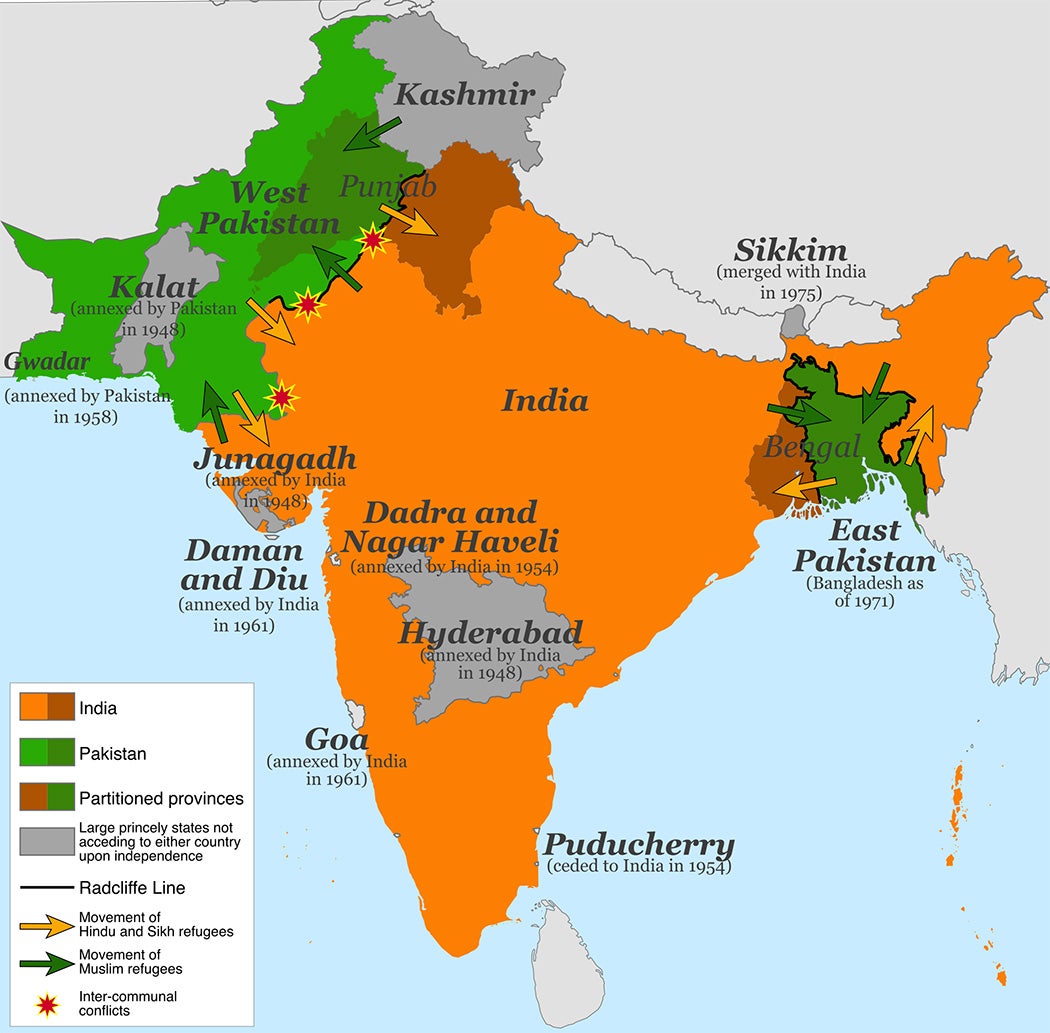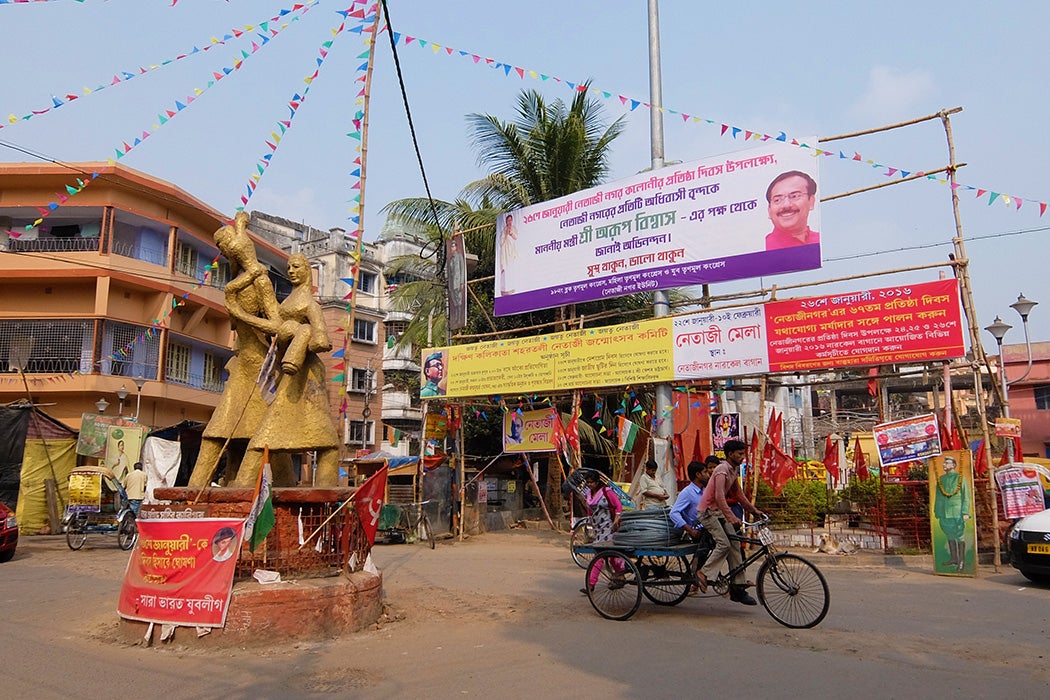Kolkata and Partition: Between remembering and forgetting
by ISTI BATTACHARYA


via Wikimedia Commons
In Netaji Nagar, a neighborhood in South Kolkata, stands a sculpture of three striding figures clutching possessions. One of them carries a child on a shoulder. Below the figures is a plaque bearing these words in Bangla, “Bastur tagide srishtir karigor, tomaderi srishti ajker ei nogor” (Compelled to create a home you became the creators of today’s city).
Netaji Nagar was one of the many refugee colonies that came up in Kolkata after India was partitioned in 1947. Based on religion, the so-called Radcliffe line divided the Indian subcontinent into Muslim-majority Pakistan and Hindu-majority India, creating two independent nations. India retained the central part of the subcontinent, its mass dividing Pakistan into two provinces, West and East, separated by some 1,000 miles. The former (Indian) State of Bengal was partitioned in the process as well. The eastern part became the province of East Pakistan (which then became the independent nation of Bangladesh in 1971); Bengal’s western region remained with India, forming the state of West Bengal, with Calcutta (now Kolkata) as its capital city.
What followed the 1947 Partition(s) was one of the biggest migrations in history as entire communities, suddenly finding themselves a minority, fled across borders—Muslims in India left for both provinces of Pakistan and Hindus and Sikhs in Pakistan moved to India. Communal violence in the nascent countries forced many families to leave their homes and belongings overnight to face an uncertain future in a new nation. In India, the states of West Bengal, Assam, and Punjab witnessed people crossing the border in large numbers. In all, more than 15 million people were displaced due to the division.
Jstor for more
On the anniversary of partition, let’s consign the pitiless logic of Hindu v Muslim to the past
by PANKAJ MISHRA & ALI SETHI

(Pankaj Mishra is a novelist and essayist from India; Ali Sethi is a writer and musician from Pakistan)
Since 1947, India and Pakistan have shared profound affinities across ferociously policed borders
In a remarkable document from the 13th century, a Sufi writer records his epiphany about the prophet Muhammad granting permission to music in India. Quoting an enigmatic utterance of the prophet (“I sense the breath of the Merciful coming from Yemen”), he speculates that the “Yemen” in question is not just the region in the Arabian peninsula, but possibly also the popular Indian raga of the same name. These days, such an innocuous interpretation, linking the founder of Islam to northern Indian music, is certain to incite charges of blasphemy, and perhaps even calls for assassination, across many Muslim populations.
But it would have been uncontroversial, even unremarkable, during much of the last millennium, the centuries during which India was the world’s busiest crossroads, receiving and transmitting cultural influences between east and west, north and south. Artists and thinkers in this time, when India played easy-going host to a polyphony of identities, were oblivious to today’s hotly invoked distinctions of religion and gender. For instance, the 14th-century Sufi poet Amir Khusrau wrote qawwali, a poetic form derived from Arabic chants, using a female persona and with imagery derived from the cult of the Hindu god Krishna. Sri Ramakrishna Paramhamsa, India’s most influential yogi in the 19th century, not only practised both Islam and Christianity; he spent many years dressed as, and imagining himself to be, a woman.
Such resourceful creativity helped pre-modern south Asians build a syncretic and broadly pluralistic society. But today it would be stigmatised in Pakistan, the “land of the pure” established 75 years ago this week as a homeland for the subcontinent’s Muslim population. Meanwhile in India, founded at the same time on a promise of secular democracy, a Hindu supremacist regime wants to purify the country’s inescapably impure past, expunging all traces of “non-Hindu” influences, including the Taj Mahal, arguably the country’s most famous monument.
In many ways, the binary constructs of “Indian” and “Pakistani” embody the desolate logic of the event that 75 years ago split British-ruled India in two: the partition, attended by massacres, rapes and large-scale dispossession. Botched products of Britain’s imperialist skulduggery – and fierce struggles for personal power between leaders of the anti-imperialist movement – the new nations were locked right from their birth into military conflict; their pitiless “identity politics” ranges today from intellectual forgeries in history textbooks to the lynching of religious minorities.
The political history of their 75 years – marked by several wars, arms races, anti-minority pogroms, authoritarian rule, and minimal protections for the poor and weak – provokes mostly despair and foreboding. While Pakistan nears economic collapse, Indian fantasies of becoming a superpower lie shattered amid shrivelled growth and ecological calamity. Demagogues in both nuclear-armed countries treacherously exploit the resulting anger and disaffection. While claiming to fulfil the broken promises of modernity, they mobilise the thwarted energies of individual and collective aggrandisement into a mass politics of fear and loathing.
The Guardian for more
As India turns 75, there is little to celebrate
by SOMDEEP SEN

On its milestone birthday, the country is faltering on several fronts.
Today, it has been 75 years since India gained its independence from British rule.
The lead-up to this occasion has been marked by much pomp and circumstance. The government of India launched the “Azadi ka Amrit Mahotsav” initiative on March 12, 2021, commencing a 75-week countdown to the 75th Independence Day. The initiative is meant to commemorate the independence struggle, celebrate ideas, actions and achievements that have shaped the nation and reinforce the country’s commitment to goals and targets that will take India to greater heights in its journey to 2047, when it will turn 100.
Though, a closer look at India’s “report card” reveals that it is faltering on several fronts. As is often the case, the Modi government has run yet another successful marketing campaign that has struck a chord with many citizens. But there is very little to celebrate about India at 75.
An economy in crisis
India’s economy is in crisis and has been since long before the beginning of the COVID-19 pandemic which devastated the global economy. Indeed, on the eve of the first COVID-19 lockdown India’s nominal gross domestic product (GDP) growth was the lowest it has been since 1975-76. Exports and investments were also on a downward trend.
As was the case the world over, the Indian economy witnessed a sharp downturn during the pandemic. GDP growth declined by 23.9 percent and, in 2020-21, the GDP shrank by 7.3 percent. The effect of this downturn was felt most severely by the country’s poorest. In 2021, a study by the Pew Research Center showed that the number of people in India living on $2 or less a day increased by 75 million due to the recession during the pandemic. This increase accounted for 60 percent of the “global increase in poverty”. The study also found that the size of the Indian middle class shrunk by 32 million in 2020. This also accounted for 60 percent of the “global retreat” from the middle class.
At present, India’s economy now seems to be somewhat on the mend. Nonetheless, the current spike in global energy and food prices due to the Russian invasion of Ukraine has had a significant effect on post-pandemic economic recovery. Food and beverage inflation has been eating the already squeezed household budgets of the poor and middle class. In June 2022, the unemployment rate was 7.8 percent – a 0.7 percent increase from May. In the 20-24 age group, the unemployment rate was at 43.7 percent. The Indian rupee has also been losing value against the dollar and this will have a detrimental effect on import-heavy sectors.
Faulty policymaking
National policymaking has not been a testament to good governance either. This was all the more evident during the pandemic. While India was classified as a country at “high risk” of a devastating COVID-19 outbreak soon after the virus was first identified in China, the government has been slow in putting in place preventive measures. The World Health Organization (WHO) declared the COVID-19 outbreak a global public health emergency on January 30, 2020. However, Prime Minister Narendra Modi’s first statement on the pandemic, in the form of a tweet did not come until March 3. The Ministry of Health and Family Welfare launched its COVID-19 awareness campaign on March 6. Until then, the only public health advice on the matter was coming from the Ministry of AYUSH (Ayurveda, Yoga & Naturopathy, Unani, Siddha and Homoeopathy). And the AYUSH advisory on COVID included little more than a list of ayurvedic and homoeopathic preventive measures and remedies.
Eventually, a national lockdown – with only four-hour notice – was announced on March 24. The way the world’s biggest lockdown was instituted itself was a testament to bad governance and misplaced political priorities. The four hours’ notice was meant to represent resolute leadership in the face of a global crisis. However, with little information on whether there would be access to vital commodities during the lockdown, panicked citizens ignored all social distancing guidelines and rushed to the stores to stock up on essentials just before locking down to prevent transmission.
The way the lockdown was implemented also failed to consider the effect it would have on the poor, especially informal and migrant workers who play a central role in the upkeep of the economies of India’s large cities. As businesses shuttered, millions found themselves jobless and without a means of transport to return to their villages. Many ended up walking hundreds of miles home, turning the lockdown into a humanitarian crisis. The prime minister apologised for the effect of the lockdown on the country’s most vulnerable and said, “When I look at my poor brothers and sisters, I definitely feel that they must be thinking, what kind of prime minister is this who has placed us in this difficulty … I especially seek their forgiveness.” He added, however, “There was no other way to wage war against coronavirus … It is a battle of life and death and we have to win it.”
Al Jazeera for more
